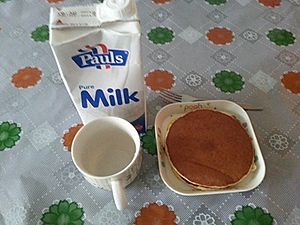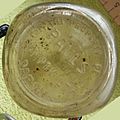Pauls (dairy) facts for kids
Pauls is a well-known Australian brand that makes many different dairy products. Its story began way back in 1923. Over the years, the company has had a few different names, like Queensland United Foods Ltd (QUF) and Pauls Ice Cream & Milk Ltd. In 1998, an Italian company called Parmalat bought Pauls. Later, in 2003, Pauls officially changed its name to Parmalat Australia Ltd. Today, Pauls is still a popular Australian brand, but it's now part of a much larger French company called Lactalis. Pauls' main office is in South Brisbane.
Contents
History of Pauls
How Pauls Started
The company officially started on June 13, 1933. It was first called Pauls Polar Perfections Pty Limited. Edward Stokes was a key person in starting the company and was still its managing director in 1951. You might see the name written as Pauls, Paul's, or Pauls' in old records.
Pauls in the 1930s
In 1933, Pauls helped sponsor a party at the Brisbane City Hall. This showed they were becoming a known name. A few years later, in 1937, a fire caused some damage to Pauls' building in North Rockhampton.
Pauls Polar Perfections Limited changed from being a private company to one that people could buy shares in. This helped them grow. They also started making fruit syrups and needed new equipment for their cold storage.
Around this time, Pauls Ice Cream and Milk Ltd became a registered seller of milk. The milk they bought from farmers was carefully checked for chemicals and bacteria to make sure it was safe. A new law about milk supply came into effect in late 1939.
Pauls in the 1940s
Even though the company was still quite new in 1946, they wrote a history book about their beginnings called Pauls Ice Cream & Milk Ltd.: a history.
Many transport companies worked with Pauls to deliver their products, including Bill Bolton's Cobb & Co. Redman Transport, which covered areas like the Darling Downs.
Pauls Milk and Ice Cream Ltd planned to build new facilities to make powdered milk. This was a big step because it meant milk farmers wouldn't have to sell their extra milk to butter factories anymore. However, after World War II, getting enough steel was a problem, which could delay the building work.
In the late 1940s and 1950s, Pauls milk was delivered in special square-shaped glass bottles with gold metal caps. These bottles first appeared in July 1948. Working for Pauls meant employees had benefits like retirement plans and social activities.
Pauls in the 1950s
In 1953, Pauls Milk Ltd started building two new factories in South Brisbane to make powdered milk. Powdered milk was helpful for people on special diets, for those in faraway places who couldn't get fresh milk, and as an option when fresh milk was scarce.
Pauls had several distribution centers around Brisbane, including in suburbs like Rocklea and Coorparoo. At that time, other milk companies in Brisbane included United Milk Vendors Pty Ltd.
From about 1956, Pauls became the main supplier of milk products to Darwin. They had a plant there that mixed some local fresh milk with reconstituted milk (milk made from powder) to supply the "Top End" region.
Pauls Today (2020s)
In January 2020, Pauls won a contract with Queensland Health to supply milk, yogurt, and other products to hospitals in the Metro North area. Some people protested, saying that a local company, Maleny Dairy, should have been chosen instead, because Pauls is part of the French-based Lactalis company.
Over its history, Pauls has changed what products it makes. It used to produce ice cream, but now it focuses on dairy items like milk, cream, custard, yoghurt, and different milk and juice drinks.
Awards and Recognition
In 2013, Queensland United Foods (QUF), which was an earlier name for Pauls, was honored by being added to the Queensland Business Leaders Hall of Fame. This was because of its success as a public company in Queensland and its important contributions to Australia's dairy industry. They were recognized for new ideas in how they made products, the products themselves, and how they marketed them.
Gallery
See also
- Dairy farming in Australia





